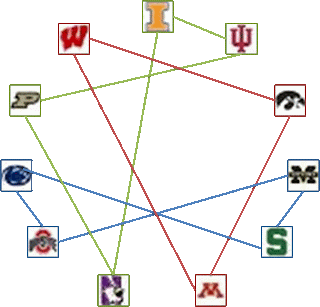Now, of those 3 factors Delany said that competitive balance was the most important. However, it makes more sense to look at the other two factors first because they are actually concrete. The rivalries have been built on tradtions dating back over 100 years in some case, and barring some sort of crazy apocalyptic tectonic shift, geography is not changing any time soon.
Rivalries
The current protected rivalries give us 3 groups. Adding Nebraska into the mix doesn't change things much. They naturally fit in best with the Iowa, Wisconsin, Minnesota triumverate from a geography perspective and they have more history with Iowa and Minnesota than any other teams in the Big Ten. So, we're left with 3 rivalry groups:- Iowa, Wisconsin, Minnesota, Nebraska
- Michigan, Michigan State, Ohio State, Penn State
- Illinois, Northwestern, Indiana, and Purdue
Geography
So, if we split up the last group it makes sense to keep Illinois and Northwestern together and thus Indiana and Purdue together. That keeps the interstate rivalries intact. The obvious move then from a geographical perspective is to send the Illinois schools over with western schools and have the Indiana schools with the eastern schools. This splits up the division geographically perfect. Every team west of the Illinois/Indiana border is in one division, every team east of the line is in another.Competitive Balance
Trying to keep each division balanced is a very inexact science. The past doesn't predict the future, but there isn't much else to base it on. If you look back through all of history, clearly Ohio State, Michigan, Penn State, and Nebraska are the breadwinners. However, if you narrow your scope, Iowa and Wisconsin start to creep into the picture. If you narrow it even further, Iowa has had much more success than Michigan.Another thing I want to point out is that I don't see a 12-team Big Ten staying at 12 teams for very long. So, these division probably need to be balance for just the next few years. Looking at 100 years of data seems kind of silly when guessing what teams are going to be the most competitive in the conference over the next 5 years. The past couple of years seem much more relevant.
With that said, I believe a division with Ohio State, Michigan, and Penn State together is not too top heavy and that a separate division with Iowa, Wisconsin, and Nebraska will match up nicely.
Division
I'm sticking with the overly simple West Division and East Division (lame, I know).West - Iowa, Wisconsin, Nebraska, Minnesota, Illinois, Northwestern
East - Ohio State, Michigan, Michigan State, Penn State, Indiana, Purdue
